| Skip Navigation Links | |
| Exit Print View | |

|
Master Index Data Manager User's Guide Java CAPS Documentation |
| Skip Navigation Links | |
| Exit Print View | |

|
Master Index Data Manager User's Guide Java CAPS Documentation |
Master Index Data Manager User's Guide
About the Master Index Data Manager
About Oracle Java CAPS Master Index
About Master Index Applications
Features of Master Index Applications
Functions of the Master Index Data Manager
Learning about MIDM Object Profiles
MIDM Object Profile Components
Source Record and SBR Components in a Master Index
Identification Numbers for each Entity in the Master Index
Working with the Master Index Data Manager
Logging in to the Master Index Data Manager
Master Index Data Manager Security Permissions
Master Index Data Manager Navigation Tips
Navigating the MIDM Detail Pages
Viewing Summary Information From the Dashboard
Accessing Reports and Audit Logs From the Dashboard
To Access Reports and Audit Logs From the Dashboard
Performing a Quick Search (EUID Lookup)
Performing an EUID Comparison Lookup
To Perform an EUID Comparison Lookup
Learning About Object Queries on the MIDM
About the MIDM Search Function
Searching by Ranges on the MIDM
Searching for Object Profiles on the MIDM
Performing an Alphanumeric Search
To Perform an Alphanumeric Search
Performing an EUID Comparison Lookup
To Perform an EUID Comparison Lookup
Working with Search Results on the MIDM
Viewing the Results of a Search
Selecting a Profile from the Results List
Sorting the Results of Your Search
Learning About Object Profile Views on the MIDM
Object Profile Details on the MIDM
Source Record Details on the MIDM
Object Profile and Source Record Comparisons
Object Profile Transaction Histories
Object Profile Merge Histories on the MIDM
Viewing Object Information on the MIDM
Viewing Object Profiles on the MIDM
Viewing a Source Record on the MIDM
Comparing Object Information on the MIDM
Comparing Two or More Object Profiles
Comparing Source Records From Object Profile Views
Comparing Source Records From One Source System
Viewing Transaction Histories on the MIDM
To View a Complete Transaction History For an Object Profile
To View Transaction History Records from the Transactions Page
About Transaction History Search Fields on the MIDM
About Transaction History Results Fields on the MIDM
Transaction History Transaction Types on the MIDM
Viewing a Profile's Merge History on the MIDM
To View an Object's Merge History
Viewing Merged Profiles for an Object Profile
To View Merged Profiles for an Object Profile
About Audit Log Search Fields on the MIDM
About Audit Log Results Fields on the MIDM
Audit Log Functions on the MIDM
Adding an Object Profile on the MIDM
Step 1: Obtain Information about the Object
Step 2: Specify a System and Local ID
To Specify a System and Local ID
Step 3: Specify Parent Object Information
To Specify Parent Object Information
Step 4: Specify Child Object Information
To Specify Child Object Information
Step 5: Save the Object Profile
Learning About MIDM Maintenance Tasks
Surviving and Non-Surviving Profiles
Handling Potential Duplicates on the MIDM
Linking Source Record Fields to the SBR
Locking Field Values in the SBR
Modifying Profile Information on the MIDM
Modifying Information in an Object Profile
Modifying Parent Object Information in a Profile
Adding a Child Object to an Object Profile
Modifying a Child Object in a Profile
Deleting a Child Object From a Profile
Modifying Information Directly in a Source Record
Modifying the Parent Object in a Source Record
Adding a Child Object to a Source Record
Modifying a Child Object in a Source Record
Deleting a Child Object From a Source Record
Overriding the Survivor Calculator's SBR
Linking an SBR Field to a Specific Source Record
Unlinking an SBR Field From a Source Record
Adding a Source Record to an Object Profile
To Add a Source Record to an Object Profile
Deactivating a Profile or Source Record
Deactivating an Object Profile
Reactivating a Profile or Source Record
Reactivating an Object Profile
Working with Potential Duplicate Profiles on the MIDM
Finding Potential Duplicate Profiles on the MIDM
About Duplicate Records Search Fields on the MIDM
Merging Potential Duplicate Profiles
To Combine Duplicate Profiles From the Comparison Page
Resolving Potential Duplicate Profiles on the MIDM
To Resolve Potential Duplicate Profiles From the Results List
To Resolve Potential Duplicate Profiles From the Comparison Page
Unresolving Potential Duplicate Profiles on the MIDM
To Unresolve Potential Duplicate Profiles From the Results List
To Unresolve Potential Duplicate Profiles From the Comparison Page
Working with Assumed Matches on the MIDM
Finding Assumed Matches on the MIDM
About Assumed Matches Search Fields
About Assumed Match Results Fields on the MIDM
Reversing an Assumed Match on the MIDM
Combining Object Information on the MIDM
Merging Object Profiles on the MIDM
Merging Source Records on the MIDM
Unmerging Object Information on the MIDM
Unmerging Object Profiles on the MIDM
Unmerging Source Records on the MIDM
The Duplicate Records function of the MIDM allows you to view any object profiles that are marked as potential duplicates of each other by the master index application. You can search for and view potential duplicate profiles on the MIDM, and then fix the potential duplication by either merging or resolving the two profiles. You can view potential duplicates that are resolved, but not those that are merged.
Perform any of the following tasks to monitor and fix potential duplicate profiles.
Potential duplicate profiles are determined based on the matching probability weight that indicates how closely two profiles match. You can easily find and compare potential duplicate profiles using the MIDM Duplicate Record function.
Figure 47 Potential Duplicate Comparison Page

The Duplicate Records basic search page appears.
Figure 48 Duplicate Records Basic Search Page
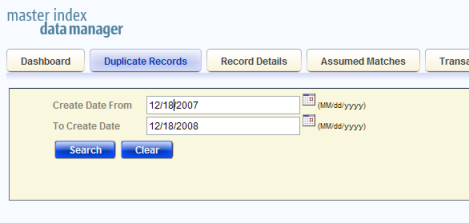
For more information about advanced search fields, see About Duplicate Records Search Fields on the MIDM.
The Duplicate Records results list appears with key information for each potential duplicate record displayed.
Figure 49 Potential Duplicate Search Results List
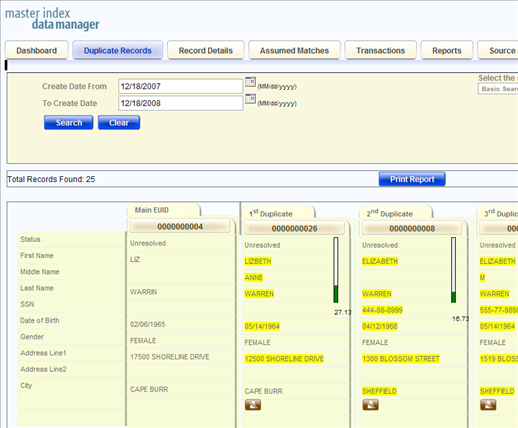
Tip - The Preview button is the blue chevron button to the right of the potential duplicate profiles.
The fields located on the Duplicate Records search page allow you to specify information about the potential duplicate profiles you want to view.
Table 7 Duplicate Records Search Fields
|
When you compare potential duplicate profiles, you might find that the object profiles represent the same entity, or that a source record from one profile actually belongs in the other profile. You can perform either an object profile merge or a source record merge to correct this. When you merge profiles, the SBR of the surviving profile is automatically recalculated based on the source records involved in the merge. You can combine up to four profiles.
This topic only describes object profile merges. For more information about merging object profiles, see Combining Object Information on the MIDM. To learn how to merge source records, see Merging Source Records on the MIDM.
Tip - The Preview button is the blue chevron button to the left of the potential duplicate profiles.
Each profile changes color to indicate it is selected.
Figure 50 Duplicate Records – Selecting Profiles to Merge
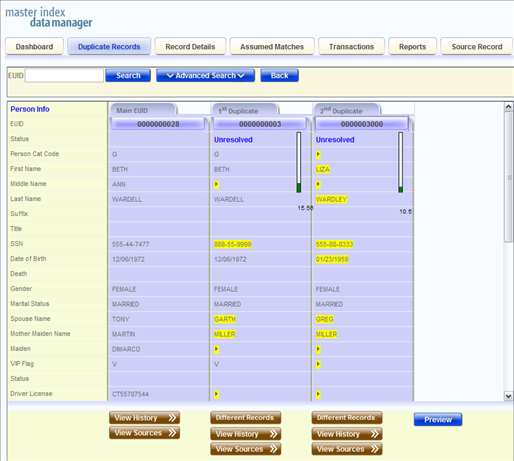
The merge preview profile appears, allowing you to view the profile as it will appear after the merge.
Figure 51 Duplicate Records – Merge Preview Profile
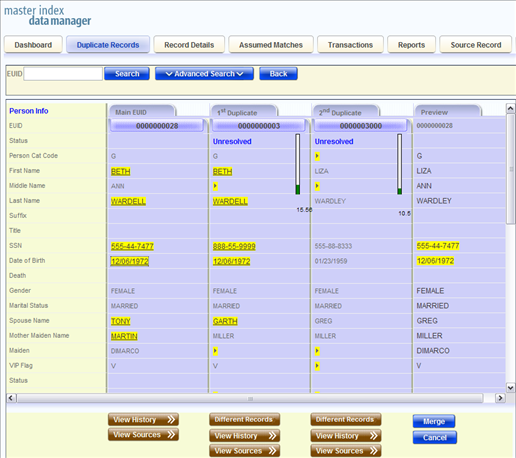
Note - Selecting a value to keep in the merge result profile creates a link from the SBR to the source record field that populated the field. For example, if the first name field from Record A is populated from Source Record 1, and you merge Record A into Record B and select the first name value from Record A, a link is created from the first name field in the resulting SBR to the first name field in Source Record 1. For more information on linking SBR fields to source record fields, see Overriding the Survivor Calculator's SBR.
The surviving profile appears.
When you compare two potential duplicate profiles and determine that they do not represent the same object, you can resolve the two profiles to flag the profiles as not being potential duplicates. There are two types of resolution. Resolve removes a potential duplicate flag, but if one of the resolved profiles is updated the records might be listed as potential duplicates again. Resolve Permanently flags the two profiles as being permanently resolved regardless of whether one of the resolved profiles is updated.
If the fields on the Duplicate Records search results list are sufficient to determine that two profiles do not represent the same object, you can resolve the profiles from the search results list.
The results list displays key identification fields that might provide enough information for you to determine whether the profiles should be resolved.
Figure 52 Duplicate Records Search Result Entry
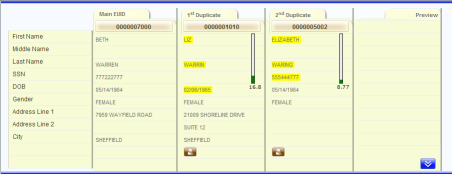
Tip - The Different Records icon is the brown icon beneath each profile.
The status of the potential duplicate entry is changed to Resolved and the profiles are no longer regarded as potential duplicates of one another.
If you need to view detailed information about two profiles to determine whether they are a match, view them on the Duplicate Records comparison screen before you resolve them.
Figure 53 Duplicate Records Comparison Page

A confirmation dialog box appears.
The status of the potential duplicate entry is changed to Resolved and the profiles are no longer regarded as possible duplicates of one another.
If two profiles were resolved and flagged as not being potential duplicates in error, you can undo the resolve transaction and mark them as potential duplicates once more. You can perform this from either the results list or the comparison page.
If the fields on the Duplicate Records search results list are sufficient to determine that a resolve transaction was performed in error, you can unresolve the profiles in the search results list.
The results list displays key identification fields that might provide enough information for you to determine whether the profiles should be unresolved.
Figure 54 Duplicate Records Search Result Entry

The status of the potential duplicate entry is changed from Resolved and the profiles are once again regarded as potential duplicates of one another.
If you need to view detailed information about two profiles to determine whether they should be unresolved, view them on the Duplicate Records comparison screen.
Figure 55 Unresolving Potential Duplicate Records

The status of the potential duplicate entry is changed from Resolved and the profiles are once again regarded as possible duplicates of one another.